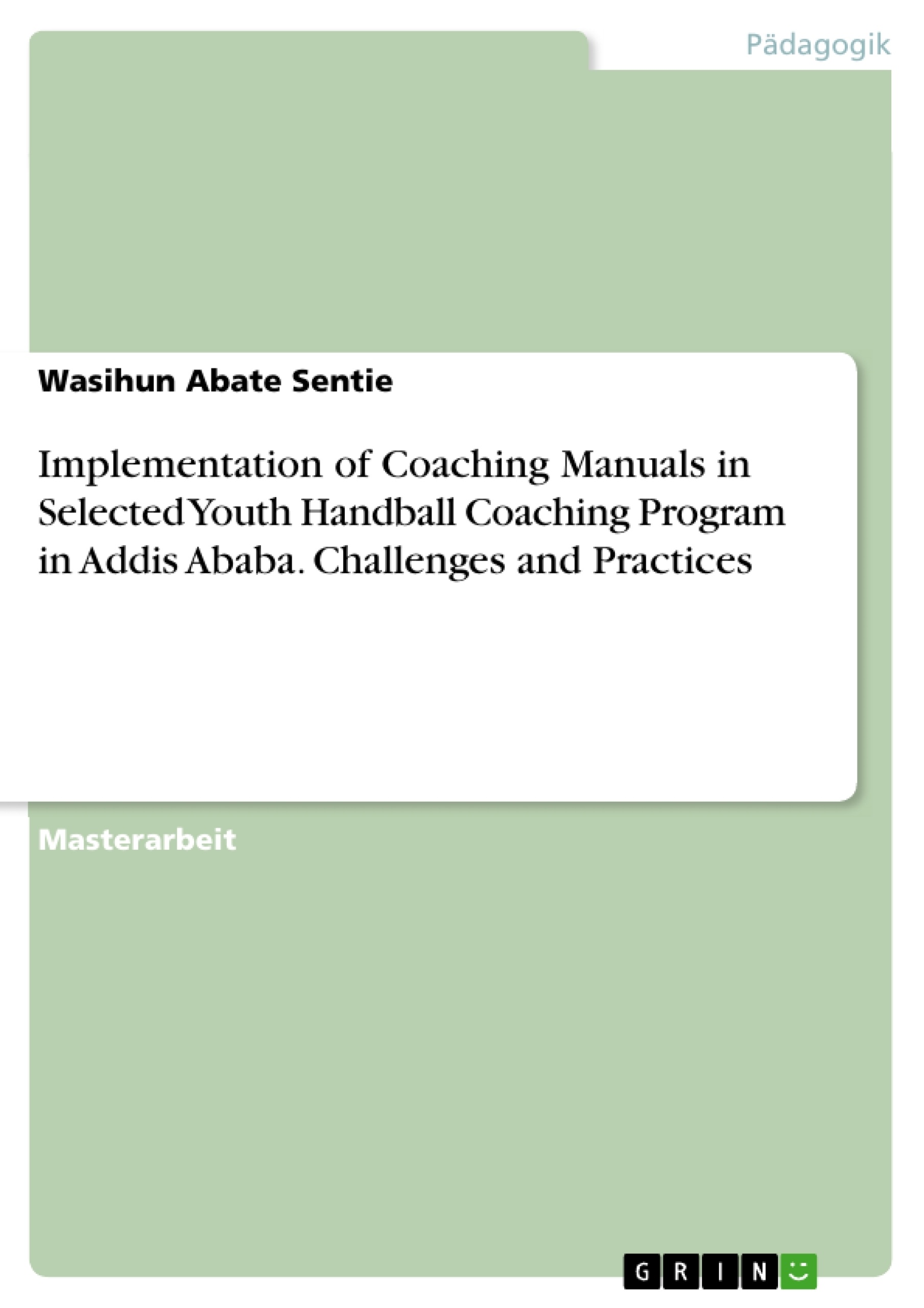The aim of this study was to assess challenges and current practices in implementation of coaching manuals in selected Addis Ababa city, Ethiopia youth handball coaching program. The study was employed a descriptive survey research method. Ten sample youth projects were selected, from twenty-four youth handball projects using stratified and purposive sampling technique.
Thus, the samples of this study were 50 players, 10 coaches and 32 sport administrative officials. The data was collected through questionnaire and observation checklist and thus, analyzed using both quantitative and qualitative methods by describing statements and frequency counts and percentages.
The specific objectives of this study were to describe the current practices in implementation of handball coaching manuals, to identify the challenges that hindered the effective implementation of handball coaching manuals and to find out how quality of coaches can affect the implementation of handball coaching manuals. It also verifies how management and organization of the training program can affect the implementation of handball coaching manuals.
Inhaltsverzeichnis
- Acknowledgement
- Table of Contents
- List of Tables
- Table of Figures
- Abbreviations and Acronyms
- Abstract
- CHAPTER ONE
- INTRODUCTION
- Background of the study
- Statement of the Problem
- Objectives of the Study
- General Objective
- Specific Objectives
- Research Questions
- Delimitation of the Study
- Limitations of the Study
- Significance of the Study
- Definition of Operational Terms
- CHAPTER TWO
- REVIEW OF RELATED LITERATURES
- History of Handball
- History of Handball in the world
- Handball in Africa
- Historical Development of Handball in Ethiopia
- Benefits of sport
- Sport Coaching
- Coaching practice
- The National Sport Policy of Ethiopia
- Youth Sport Projects in Ethiopia
- What makes a successful inner-city sporting projects?
- Contribution of Youth (junior) Coaching
- Responsibility of Coach
- Determinants of sport project coaching implementation
- Financial resources
- Management and Administrative affairs
- Sport Organization
- Supply of Sport Material
- Quality Factors of Good Coaches
- Condition of Trainees
- Trainees Interest and Consistency
- Talent Scouting and Identification
- Family (Community) Support
- Program Design
- Monitoring and Evaluation
- CHAPTER THREE
- RESEARCH DESIGN AND METHODOLOGY
- Description of the Study Area
- Research Design
- Study Population
- Sample Size & Sampling Technique
- Source of Data
- Data Collection Instrument
- Procedures of Data Collection
- Method of Data Analysis
- Pilot Study
- Reliability and Validity
- CHAPTER FOUR
- RESULTS AND DISCUSSION
- Analysis of Results
- Socio- Demographic Characteristics
- Analysis of current program implementation
- Analysis of causes that encounter coaching handball
- Analysis of Results on Coach's Quality
- Analysis of field observation
Zielsetzung und Themenschwerpunkte
Diese Arbeit untersucht die Herausforderungen und Praktiken bei der Implementierung von Coaching-Handbüchern in ausgewählten Jugend-Handball-Trainingsprogrammen in Addis Abeba. Sie zielt darauf ab, ein tiefes Verständnis für die Faktoren zu entwickeln, die die effektive Umsetzung von Coaching-Handbüchern beeinflussen, sowie die Herausforderungen, denen Trainer und Administratoren bei der Umsetzung dieser Programme gegenüberstehen.
- Herausforderungen bei der Implementierung von Coaching-Handbüchern in Jugend-Handball-Trainingsprogrammen
- Die Rolle von Finanzmitteln und Ressourcen bei der effektiven Coaching-Implementierung
- Die Bedeutung von Management und Administration in der Umsetzung von Coaching-Programmen
- Die Qualität von Trainern und deren Einfluss auf die erfolgreiche Implementierung von Programmen
- Die Bedeutung der Talentförderung und -identifizierung im Jugend-Handball
Zusammenfassung der Kapitel
- Kapitel Eins: Einleitung
- Dieses Kapitel führt den Leser in die Forschungsarbeit ein und stellt den Hintergrund, das Problem, die Ziele und die Forschungsfragen der Arbeit dar. Es werden außerdem die Begrenzungen und die Bedeutung der Arbeit erläutert.
- Kapitel Zwei: Literaturüberblick
- Dieses Kapitel beleuchtet die vorhandene Literatur zur Geschichte des Handballs, den Vorteilen von Sport, Coaching-Praktiken und dem nationalen Sportpolitik in Äthiopien. Es analysiert die verschiedenen Faktoren, die die Implementierung von Sportprojekten beeinflussen, insbesondere im Hinblick auf die Jugend.
- Kapitel Drei: Forschungsdesign und Methodik
- Dieses Kapitel beschreibt die angewandte Forschungsmethode, einschließlich des Studiengebiets, des Designs, der Stichprobengröße, der Datenerhebung und der Analysemethoden. Es beleuchtet auch die Maßnahmen zur Sicherstellung der Zuverlässigkeit und Gültigkeit der Forschung.
- Kapitel Vier: Ergebnisse und Diskussion
- Dieses Kapitel präsentiert die Ergebnisse der Datenerhebung und Analyse, einschließlich der soziodemografischen Merkmale der Teilnehmer, der aktuellen Implementierung von Coaching-Programmen und der Herausforderungen, denen die Trainer und Administratoren bei der Implementierung von Handball-Coaching-Programmen gegenüberstehen.
Schlüsselwörter
Handball, Jugendtraining, Coaching-Handbücher, Implementierung, Herausforderungen, Praktiken, Äthiopien, Addis Abeba, Talentförderung, Finanzmittel, Management, Administration, Trainerqualität.
- Arbeit zitieren
- Wasihun Abate Sentie (Autor:in), 2019, Implementation of Coaching Manuals in Selected Youth Handball Coaching Program in Addis Ababa. Challenges and Practices, München, GRIN Verlag, https://www.grin.com/document/1371293



